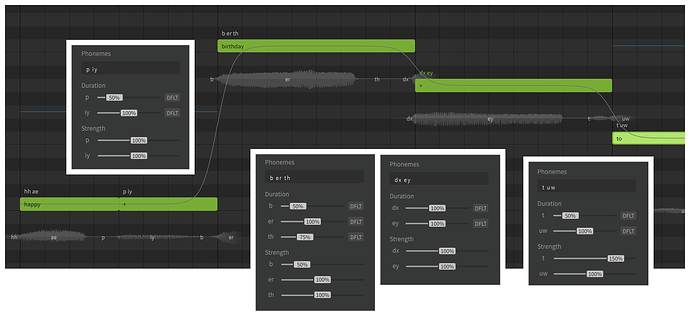In general sampling programs, legato is usually achieved by having the notes overlap a bit. In Synth V that cancels the notes so no sound comes out. In Synth V, is legato achieved by altering the duration left or right in pitch transition?
Enter a note’s lyric as a minus sign (-) to extend the previous lyric across multiple notes.
You can also adjust the pitch line with the pencil tool to deviate away from the exact pitch of the notes.
You are correct - there is no overlap allowed in SynthV. Any notes that are adjacent are automatically “legato”, in the sense that they are smoothly connected.
And yes, you can adjust the at what point the transition begins by modifying the Offset, and how quickly it levels off with Left Offset and Right Offset.
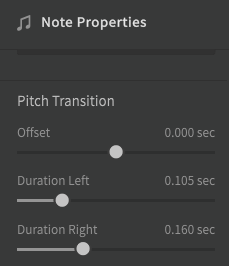
Since these attributes are pitch modifications, you can also draw in the pitch curve by editing the Pitch Deviation directly in the Parameters window.
Thank you Claire for your response and for indications where to find more information in the manual. And dcuny thanks for the graphic. I’m sure with the explanations and experimentation I’ll get legato for certain parts of phrases and words that even though they have multiple syllables, musically they need to run into each other.
To clarify the terminology, a melisma is when a multiple notes are assigned to a single syllable, like so:
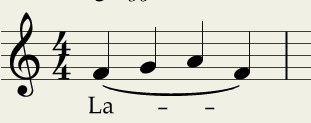
On the other hand, legato refers to when adjacent notes are connected together smoothly, with no rest between the notes.
Even though we may imagine that when we speak and sing that there are rests between words, that’s not actually the case.
When singing, unless a rest is placed between the notes, notes are continuous (connected) and legato. For example, in the image below:
- There are no breaks in the waveform
- The pitch line moves smoothly from one note to the next
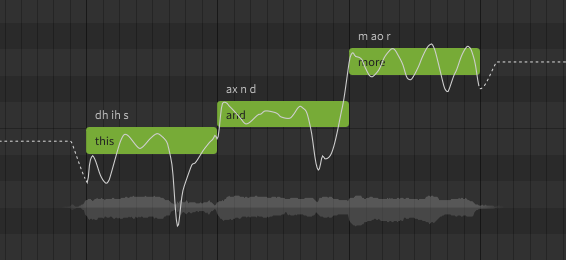
In contrast, if a rest is placed between the notes, you can see
- There are separate waveforms for each word, with gaps between each note
- The pitch line between words is dotted, indicating there is no sound at those points
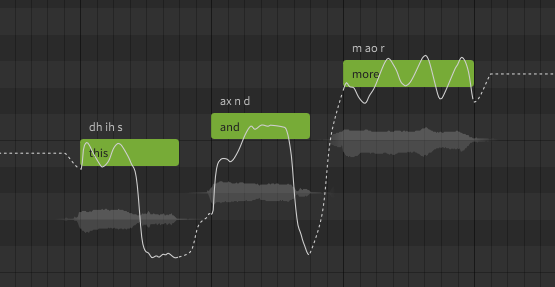
In violin terms - legato is when the bow continues to move during the change of the note. By the nature of voice, we can’t immediately skip from one note to the next, so there will be portamento (sliding from one pitch to the next) as well.
Ah, yes I suppose while we often use “legato” in vocal synth contexts to refer to the pitch transition or “note bends” it is, in actuality, a descriptor of articulation.
In that sense there are a few additional things that you can do to make a legato even smoother than the default, or a staccato even more abrupt.
The default legato is already quite smooth, however you might find some voice databases tending toward a staccato behavior if that’s what the original voice provider used during the initial recording phase, or simply based on the lyrics of your phrase.
In this case (especially with stops like t, d, k, or p) you may need to modify the individual phoneme settings to get a smoother transition.
For example, these notes are connected but the stops throughout the lyrics still include a lot of gaps in the waveform, which might come across as more of a staccato than you’d expect.
There are a few main ways to resolve this:
- Replace harsher stops with “lazier” ones, like
dwithdx - Reduce the phoneme duration of the stops
- Reduce the phoneme strength of the stops (Pro only, tends to be a similar but more subtle version of point #1)
- Increase the phoneme strength of the stops (Pro only, can make the silent portion of the stop shorter and the vocalized portion longer)
Of course you’ll want to be careful that it doesn’t completely lose clarity or it’ll sound like mumbling, however this version where I’ve used the above techniques is notably smoother than the default.
As for staccato, beyond just separating the notes you can also include sil (silence) notes before and cl (glottal stop) after to force a shorter lead-in and tail to the note (which sometimes extends beyond the actual start and end of the note to emulate human singing).

